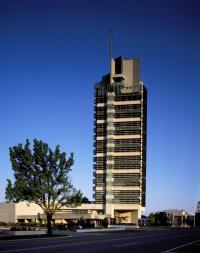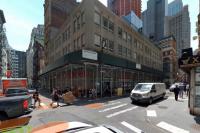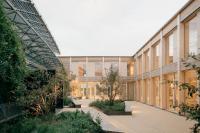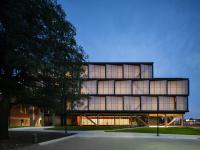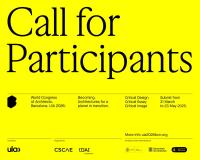European Central Bank (ECB)
Frankfurt/M., Germany
New premises of the European Central Bank (ECB), Frankfurt, Germany (2003-2014)
The striking twin tower shapes the skyline of Frankfurt’s Ostend
The design of the Viennese architectural studio Coop Himmelb(l)au for the new premises of the European Central Bank in Frankfurt combines the horizontal structure of the landmarked Grossmarkthalle with a twisted double tower, which rises to 185 meters. United by an entrance building, these two elements form an ensemble of special architectural significance. Featuring bridges, pathways and platforms, the glass atrium between the two highrises creates a vertical city. The semi-public and communicative functions are located in the former Grossmarkthalle. The exceptional atrium and visible steel support structure show that the ECB building belongs to an entirely new typologie of skyscrapers.
The hyperboloid cut – From the beginning it was an explicit order of the ECB to create a unique, iconic building as a symbol for the European Union. A distinctiv and unique building can only be achieved by a completely different kind of Geometry. The design concept of the ECB is to vertically divide a monolithic block through a hyperboloid cut, wedge it apart, twist it and fill the newly created intermediary space with a glass atrium. The result is a very complex geometry and a multifaceted building offering a completely different appearance from each angle: massiv and powerful from the South-East, slender and dynamic from the West.
The principle of the “Vertical City” – The architectural concept of the ECB is to vertically divide a monolithic block through a hyperboloid cut, wedge it apart, twist it and fill the newly created intermediary space with several glass atriums. The connecting and transitioning levels divide the atrium horizontally into three sections with heights from 45 to 60 meters. This is where all vertical entry points are joined – and just like public squares, they invite visitors to communicate. The planned “hanging gardens” ensure a pleasant room climate while elevators and stairs connect these places with the offices and communication areas of the Grossmarkthalle.
The Grossmarkthalle – the communicative forum – The existing landmarked Grossmarkthalle, a former wholesale market from the 1920s, is used as an “urban foyer”. The conference and visitor’s center, library and employee cafeteria are placed diagonally in the spacious interior of the hall as independent building structures (with a “house within a house” concept). A floating entrance building penetrates the hall structure from the outside. With its asymmetrical contours, slanted facades and generous windows it marks the representative access to the ECB. The lobby, two-story press conference room and a lecture room are located here. The so-called “loop” – a glass walkway between the highrise and the market hall – completes the ensemble.
The sustainable energy concept – Energy efficiency and sustainability were key factors in the competition. The energy concept includes the following measures: utilization of rain water, heat recovery, efficient insulation, sun protection and illumination as well as a natural ventilation for the offices. Some areas, such as the atrium and open zones of the Grossmarkthalle, are not equipped with an air conditioning system; instead they serve as a buffer zone between the interior and exterior climates. The "shield hybrid facade" of the office towers consists of three layers and offers a direct and natural ventilation of the offices via vertical, room-high ventilation elements.
Urban construction and architecture – The ECB’s architecture was carefully attuned to its location in Frankfurt’s Ostend district. With its clear orientation towards the urban perspectives, the ensemble enters a dialogue with Frankfurt’s most important reference points: the Alte Oper, the Museum Embankment and the skyline of the financial district. The distinctive double tower can be seen from all of the important places in Frankfurt’s city center and from the Main river, creating an initial point for a second center in the East of Frankfurt.
“This corresponds to the principle of a polycentric city, which is much more dynamic than a monocentric city,” explains Wolf D. Prix, Design Principal and CEO of Coop Himmelb(l)au. “Tension areas begin to emerge between the centers, in which new developments are being provoked.”
Hessian Culture Prize – Wolf D. Prix received the prestigious Hessian Culture Prize for the design of the new premises of the European Central Bank in November 2013. Since 1982, this award has been given annually for special accomplishments in the areas of art, science and cultural mediation. “With the new premises of the European Central Bank, Coop Himmelb(l)au is creating a new, modern landmark for Frankfurt,” the eleven-member Board of Trustees said in a statement about the award.
+++
Neubau der Europäischen Zentralbank (EZB), Frankfurt (2003-2014)
Der markante Doppelturm prägt die Skyline des Frankfurter Ostend
Der Entwurf des Wiener Architekturbüros Coop Himmelb(l)au für den Neubau der Europäischen Zentralbank in Frankfurt kombiniert den liegenden Hallenbau-körper der denkmalgeschützten Großmarkthalle mit einem rund 185 Meter hohen spektakulär verdrehten Doppel-Büroturm. Ein Eingangsbauwerk verbindet diese beiden Elemente zu einem Gebäudekomplex von besonderer städtebaulicher Bedeutung. Das turmhohe gläserne Atrium zwischen den zwei Bürotürmen schafft mit Brücken, Stegen und Plattformen eine vertikale Stadt mit Straßen und Plätzen. Die halböffentlichen und kommunikativen Funktionen sind in der ehemaligen Großmarkthalle untergebracht. Mit dem außergewöhnlichen Atrium und dem sichtbaren Stahltragwerk stellt das EZB Gebäude einen neuen Hochhaustypus dar.
Der hyperbolische Schnitt – Der dezidierte Auftrag der EZB lautete, ein unverwechselbares, ikonisches Gebäude als Symbol für die Europäische Union zu entwerfen. Ein unverwechselbares Gebäude entsteht nur durch eine andere, neuartige Geometrie. Das Entwurfskonzept der EZB besteht darin, einen monolithischen Block durch einen hyperbolischen Schnitt vertikal zu teilen, auseinanderzurücken, dann gegeneinander verdreht mit den gekrümmten Seiten nach außen aufzustellen und die Zwischenräume mit einem gläsernen Atrium zu füllen. Das Resultat ist eine sehr komplexe Geometrie und ein facettenreiches Gebäude, das je nach Blickrichtung ein vollkommen anderes Erscheinungsbild bietet: massiv und mächtig vom Süd-Osten aus, schlank und dynamisch vom Westen aus.
Das Prinzip „Vertikale Stadt“ – Das Atrium ist durch Verbindungs- und Umsteigeebenen horizontal in drei Abschnitte unterteilt. Hier laufen alle vertikalen Erschließungswege zusammen – wie Stadtplätze laden sie zur Kommunikation ein. Die geplanten „hängenden Gärten“ sorgen für ein angenehmes Raumklima, Aufzüge und Treppen verbinden diese Plätze mit den Büros und den Kommunikationsbereichen der Großmarkthalle.
Die Großmarkthalle – das kommunikative Forum – Die vorhandene denkmalgeschützte Großmarkthalle aus den 1920er Jahren wird als „urbanes Foyer“ genutzt. Konferenz- und Besucherzentrum, Bibliothek und Mitarbeiterrestaurant stehen diagonal angeordnet als unabhängige Baukörper im geräumigen Innenraum der Halle („Haus im Haus“-Konzept). Ein schwebendes Eingangsbauwerk durchbricht außen die Struktur der Halle und markiert mit seinem asymmetrischen Zuschnitt, den schrägen Fassaden und großzügigen Fensterflächen den repräsentativen Zugang zur EZB. Hier befinden sich die Lobby, der zweige-schossige Pressekonferenzraum und ein Vortragssaal. Der sogenannte „Loop“ – eine Art gläserner Gang zwischen Hochhaus und Markthalle – komplettiert das Ensemble.
Das nachhaltige Energiekonzept – Zentrale Vorgaben des Wettbewerbes waren Energieeffizienz und Nachhaltigkeit. Das Energiekonzept beinhaltet folgende Maßnahmen: Nutzung von Regenwasser, Wärmerückgewinnung, effiziente Isolierung, Sonnenschutz und Beleuchtung sowie natürliche Belüftung der Büroräume. Einige Bereiche wie Atrium und offene Bereiche der Großmarkthalle sind nicht mit einer Klimaanlage ausgestattet, sondern dienen als Klimapuffer zwischen Innen und Außen. Die sogenannte „Schild-Hybrid-Fassade“ der Bürotürme besteht aus drei Fassadenschichten und ermöglicht die direkte natürliche Belüftung der Büros über vertikale, raumhohe Lüftungselemente.
Städtebau und Architektur – Die Architektur der EZB wurde sehr sorgfältig auf den Standort im Frankfurter Ostend abgestimmt. Durch die klare Ausrichtung auf die städtebaulichen Sichtachsen tritt das Ensemble in Dialog mit den wichtigen Bezugspunkten Frankfurts: mit der Alten Oper, dem Museumsufer und der Skyline des Bankenviertels. Der markante Doppelturm ist von allen wichtigen Standorten der Frankfurter Innenstadt wie auch vom Main aus sichtbar und bildet den Ausgangspunkt für ein zweites Zentrum im Osten Frankfurts. „Das entspricht dem Prinzip der polyzentrischen Stadt, die wesentlich dynamischer ist, als die monozentrische Stadt“, erklärt Wolf D. Prix, Design Principal und CEO von Coop Himmelb(l)au. „Zwischen den Zentren entstehen Spannungsfelder, in denen neue Entwicklungen provoziert werden.“
Hessischer Kulturpreis – Für den Entwurf des Neubaus der Europäischen Zentralbank hat Wolf D. Prix im November 2013 den renommierten Hessischen Kulturpreis erhalten. Diese Auszeichnung wird seit 1982 jährlich für besondere Leistungen in den Bereichen Kunst, Wissenschaft und Kulturvermittlung verliehen. „Mit dem Neubau der Europäischen Zentralbank schafft Coop Himmelb(l)au ein neues, modernes Wahrzeichen für Frankfurt“, begründete das elfköpfigen Kuratoriums die Ehrung.
Client
European Central Bank (ECB), Frankfurt/M., Germany
Architect
Planning: COOP HIMMELB(L)AU – Wolf D. Prix, Helmut Swiczinsky, Wolfdieter Dreibholz ZT GmbH
Design Principal: Wolf D. Prix
Project Partner: Frank Stepper
Design Architects: Karin Miesenberger, Stefan Rutzinger, Kristina Schinegger
Project Architects: Hartmut Hank, Christian Halm, Thomas Schwed, Michael Beckert (TPL), Johannes Behrens (TPL), Günther Weber, Jürgen Tiltmann (TPL), Oliver Cassik (TPL), Philipp Munz (TPL)
Architectural Management: Christian Maeder, Sascha Hempel, Markus Tritthart, Damian Witt
Project Team: Magdalena Baczkowska, Markus Baumann, Michael Beckert, Johannes Behrens, Hilde Benda, Marcelo Bernardi, Nico Boyer, Jan Brosch, Timo Carl, Anna Rita Cedroni, Jasmin Dieterle, Sabrina Dlugosch, Jan Ruben Fischer, Brigitte Fuchs, Sergio Gonzales, Gesine Görlich, Martin Gruber, Guthu Hallstein, Sebastian Haffner, Simone Hainz, Sascha Hempel, Rob Henderson, Emanuele Iacono, Martin Jelinek, Rashmi Krishna Jois, Ivana Jug, Frank Pascal Kaul, Matt Kirkham, Daniela Kröhnert, Bernward Krone, Christian Labud, Anke Lammert, Monika Lyzyczka, Steven M, Christian Maeder, Dimitra Mamou, Ariane Marx, Christoph Maurer, Matthias Niemeyer, Martin Oberascher, Ross Olson, Renate Ott, Gerhard Pfeiler, Ellen Pietrzyk, James Pike, Robert Pippan, Jakob Przybylo, Anna Ptaszynska, Stephanie Rathgeber, Carmen Renz, Salome Reves, Donna Riedel, Akvile Rimantaite, Pete Rose, Penelope Rüttimann, Stefan Rutzinger, Oliver Sachse, Kristina Schinegger, Benjamin Schmidt, Marita Schnepper, Thomas Siegl, Ebru Simsek-Lenk, Denise Sokolowski, Augustin Solorzano, Anja Sorger, Andrea Stöllenwerk, Ernst Stockinger, Crystal K.H Tang, Jürgen Tiltmann, Markus Tritthart, Josef Tröster, Günther Weber, Andreas Weissenbach, Clemens Werb, Judith Werkhäuser, Markus Wings, Eva Wolf, Barbara Zeleny, Thomas Zengger, Zeyneb Badur, Fabien Barthelemey, Oliver Cassik, Alejandro Corena, Alexander Daxböck, Mario Dignöss, Helmut Frötscher, Annegret Haider, Christian Halm, Gregor Kassl, Gernot Köfer, Alexander Laber, Anita Lischka, Rangel Malinov, Oliver Martinz, Philipp Munz, Barbara Roller, Nicole Rumpler, Wolfgang Ruthensteiner, Stefan Salchinger, Stefan Schadenböck, Thomas Schwed, Hannes Schwed, Eckart Schwerdtfeger, Sylvia Spernbauer, Christoph Treberspurg, Johannes Weigl
Model building: Ivana Jug, Filip Adamczak, Anna Balint, Mark Balzar, Oliver Berger, Robert Campell, Julian Chiellino, Ariane Dehghan, Jasmin Dieterle, Guido Ebbert, Heike Folie, Emilia Grzadzielewska, Benjamin Hahn, Laura Hannappel, Thomas Hindelang, Michael Hirschbichler, Ulrich Hoke, Rafal Jedlinski, Malte Kaiser, Reyhan Kargi, Vera Kleesattel, Stefan Kotzenmacher, Quirin Krumbholz, Daniel Kuhnert, Gretha Kuustra, Malgorzata Labecka, Jelena Lazic, Marta Leszczynska, Jörg Lonkwitz, Rita Lopez, Ariane Marx, Bruno Mock, Sarah Müller, Yusuke Nishimura, Seoug O, Ross Olson, Ulrich Peintner, Fabian Peitzmeier, Anna Ptaszynska, Jois Rashmi, Danuta Ratka, Salome Reeves, Benjamin Schmidt, Thomas Stock, Kadri Tamre, Philipp Trumpke, Andreas Wachter, Angelika Wiegand, Melanie Wohlrab
Structural Engineering
B+G Ingenieure, Bollinger und Grohmann GmbH, Frankfurt/M.
Chronology
Competition: Phase 1: 2003, Phase 2: 2003-2004, Revision Phase: 2004
Optimization Phase: 2005
Start of Planning: 2005
Preliminary site works: 2008
Main construction works: 2010
Completion: 2014
Project Data
Site area: 120,000 m²
Gross floor area: 185,000 m²
Data high-rise
Floor space per office tower: 700 to 1200 m² (varying according to shape)
Height of high-rise: 185 m - North tower ( 45 floors incl. technical floors)
165 m - South tower (43 floors), 220 meters high incl. the communication mast
Individual sections within the atrium: 45 to 72 m height, 18 m width
Lifts in the high-rise: 2 goods lifts, 5 express lifts, 9 twin lifts, 2 special lifts
Number of depth of the foundation piles: 97 piles maximum 37 meters
Data Grossmarkthalle
Internal length and width of the hall: 220 m x 50 m = 11,000 m²
Height of the hall: 23.50 meters at the highest point of the barrel vaults
Internal length and width of the wing buildings: 65 m x 15 m = 975 m²
Height of the office wings: 32.50 meters – 8 floors
Heigth of the entrance building: maximum 27.50 meters
- Architects
- Coop Himmelb(l)au
- Location
- Sonnemannstraße 20, 60314 Frankfurt/M., Germany
- Year
- 2014























